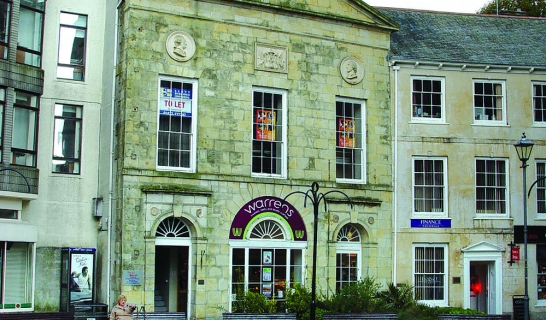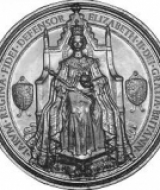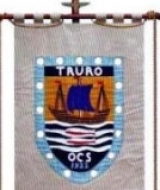Truro's History
The hillsides around the estuary valley that contains Truro have been settled since, at least, the Bronze Age. In medieval times the town was established where the three rivers (Tre-ru) - the Kenwyn, Allen and Glasteinan (or Tinney) - converge to form the Truro River, which flows into the River Fal.
Truro was, and still is, a busy port and during the civil war between King Stephen and Queen Matilda, a castle was built. Its site later became the cattle market, until this moved to the outskirts and gave way to the Crown Courts.
Earl Richard of Cornwall, brother of Henry III and King of the Romans, granted Truro its first charter in the 12th century. This was later renewed by Queen Elizabeth 1st. The Charters gave Truro the right to hold markets - a right that it retains to this day.
From early medieval times Truro has been a Stannary Town. All tin was taxed by the Earl (from 1337 to today, the Duke). Tin was brought to one of five Stannary Towns and assayed. The Duke's due was then chipped from each ingot before the metal was shipped. The Stannaries included a Convocation (or Parliament) and a legal system.
The Town Hall in the Municipal Buildings, upstairs from Tourist Information Centre, was the Stannary Court in the later part of the 19th century until regular hearings were ended. Today the Stannary Court is occasionally convened in the Crown Court.
The port of Truro has moved around. In medieval times, when a Dominican Priory sat in the shadow of the castle, the port was where Victoria Square is today. When a ship came into port, men would hurry through Truro's opes and alleyways to unload the cargo.
When Henry VIII dissolved the monasteries Truro lost its Priory. This was situated between River Street and Kenwyn Street, whilst Victoria Square was the Port of Truro. The deer park extended up as far as Infirmary Hill. The Prior's cemetery now lies under Truro Telephone Exchange. The only known remnants of the Priory are the garden wall of the King William IVth, a closed well in Kenwyn Street and a sculpted bas relief head in the rear courtyard of the Yak and Yeti Restaurant.
By the 18th century it had retreated to Lemon Quay. The Lemon family, from Carclew, near Mylor, were leading merchants who built the quay, and the surrounding streets, including, of course, Lemon Street. It was one of the earliest parts of any town to be built on a grid system.
Today, the port is opposite Boscawen Park, at Lighterage Quay, whilst Lemon Quay is a lively and attractive civic space where many activities and events occur, including the Farmers' Market on Wednesdays and Saturdays (by ancient Charter right!).
Richard and John Lander did not so much ‘put Truro on the map' as make the first detailed map of the River Niger in Africa. Richard can be seen, watching over his home town from atop his column up Lemon Street. One of Truro's two secondary schools is named after him. Lander was followed to Africa by missionary, Henry Martyn, who is as much remembered for his tragically unrequited love affair with Lydia Grenfell as for his piety and early death amongst those to whom he ministered.
In St Mary's Street visitors will find Truro Grammar School. Its most famous master was Cornelius Cardew, whose portrait hangs in the City Council chamber. He was also Mayor.
Sir Humphry Davy, historian Richard Polwhele, Admiral Sir Edward Pellew and many others were all educated at the school, which was one of the oldest schools in Britain until it closed in the 19th century.
One of Cornwall's few excellent and atmospheric private libraries - the Courtney Library - named after Sir Leonard Courtney, a campaigner in Parliament for the vote for women in the late 19th century - is sited within the Royal Cornwall Museum, whose collections are varied and significant.
Today, Truro is a business and administrative centre. Shopping is the best in Cornwall. The Cathedral stands beside the elegant Methodist Chapel, and a fine 1960s Roman Catholic Church, a Friends Meeting House, and a Baptist Church using the ancient former Lake's Pottery in Chapel Hill are nearby. With a number of other faiths and denominations all meeting in Truro it is a spiritual centre and, with five junior, two secondary, two public schools and two ‘prep' schools, as well as the excellent Truro FE College, Truro is an educational centre too. It links quickly via the Falmouth branch line with two of Cornwall's university campuses at Penryn and Falmouth.
Truro was, and still is, a busy port and during the civil war between King Stephen and Queen Matilda, a castle was built. Its site later became the cattle market, until this moved to the outskirts and gave way to the Crown Courts.
Earl Richard of Cornwall, brother of Henry III and King of the Romans, granted Truro its first charter in the 12th century. This was later renewed by Queen Elizabeth 1st. The Charters gave Truro the right to hold markets - a right that it retains to this day.
From early medieval times Truro has been a Stannary Town. All tin was taxed by the Earl (from 1337 to today, the Duke). Tin was brought to one of five Stannary Towns and assayed. The Duke's due was then chipped from each ingot before the metal was shipped. The Stannaries included a Convocation (or Parliament) and a legal system.
The Town Hall in the Municipal Buildings, upstairs from Tourist Information Centre, was the Stannary Court in the later part of the 19th century until regular hearings were ended. Today the Stannary Court is occasionally convened in the Crown Court.
The port of Truro has moved around. In medieval times, when a Dominican Priory sat in the shadow of the castle, the port was where Victoria Square is today. When a ship came into port, men would hurry through Truro's opes and alleyways to unload the cargo.
When Henry VIII dissolved the monasteries Truro lost its Priory. This was situated between River Street and Kenwyn Street, whilst Victoria Square was the Port of Truro. The deer park extended up as far as Infirmary Hill. The Prior's cemetery now lies under Truro Telephone Exchange. The only known remnants of the Priory are the garden wall of the King William IVth, a closed well in Kenwyn Street and a sculpted bas relief head in the rear courtyard of the Yak and Yeti Restaurant.
By the 18th century it had retreated to Lemon Quay. The Lemon family, from Carclew, near Mylor, were leading merchants who built the quay, and the surrounding streets, including, of course, Lemon Street. It was one of the earliest parts of any town to be built on a grid system.
Today, the port is opposite Boscawen Park, at Lighterage Quay, whilst Lemon Quay is a lively and attractive civic space where many activities and events occur, including the Farmers' Market on Wednesdays and Saturdays (by ancient Charter right!).
Richard and John Lander did not so much ‘put Truro on the map' as make the first detailed map of the River Niger in Africa. Richard can be seen, watching over his home town from atop his column up Lemon Street. One of Truro's two secondary schools is named after him. Lander was followed to Africa by missionary, Henry Martyn, who is as much remembered for his tragically unrequited love affair with Lydia Grenfell as for his piety and early death amongst those to whom he ministered.
In St Mary's Street visitors will find Truro Grammar School. Its most famous master was Cornelius Cardew, whose portrait hangs in the City Council chamber. He was also Mayor.
Sir Humphry Davy, historian Richard Polwhele, Admiral Sir Edward Pellew and many others were all educated at the school, which was one of the oldest schools in Britain until it closed in the 19th century.
One of Cornwall's few excellent and atmospheric private libraries - the Courtney Library - named after Sir Leonard Courtney, a campaigner in Parliament for the vote for women in the late 19th century - is sited within the Royal Cornwall Museum, whose collections are varied and significant.
Today, Truro is a business and administrative centre. Shopping is the best in Cornwall. The Cathedral stands beside the elegant Methodist Chapel, and a fine 1960s Roman Catholic Church, a Friends Meeting House, and a Baptist Church using the ancient former Lake's Pottery in Chapel Hill are nearby. With a number of other faiths and denominations all meeting in Truro it is a spiritual centre and, with five junior, two secondary, two public schools and two ‘prep' schools, as well as the excellent Truro FE College, Truro is an educational centre too. It links quickly via the Falmouth branch line with two of Cornwall's university campuses at Penryn and Falmouth.
Quality sites
- Non Gamstop Casinos
- Casinos Not On Gamstop
- Non Gamstop Casinos
- Non Gamstop Casino
- UK Online Casinos Not On Gamstop
- Non Gamstop Casinos UK
- Slots Not On Gamstop
- Non Gamstop Casino UK
- Casinos Not On Gamstop
- Casinos Not On Gamstop
- Best Casinos Not On Gamstop
- Non Gamstop Casinos
- Betting Site
- Non Gamstop Casinos
- Non Gamstop Casinos
- Slots Not On Gamstop
- UK Online Casinos Not On Gamstop
- UK Casinos Not On Gamstop
- Casinos Not On Gamstop
- Casinos Not On Gamstop
- New Casinos Not Blocked By Gamstop


